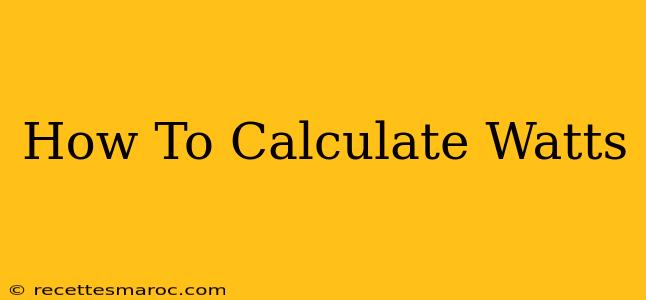Understanding how to calculate watts is crucial for anyone dealing with electricity, whether you're choosing the right lightbulb, sizing a power supply for your computer, or simply understanding your energy consumption. Watts (W) represent the rate at which energy is used, and knowing how to calculate them is a fundamental aspect of electrical engineering and everyday life. This guide will break down the process in simple, easy-to-understand steps.
Understanding the Basics: Volts, Amps, and Watts
Before diving into calculations, let's establish the relationship between volts (V), amps (A), and watts (W). These three units are fundamental to understanding electrical power:
- Volts (V): Measure the electrical potential difference, or the "push" that drives the electrons through a circuit. Think of it as the pressure in a water pipe.
- Amps (A): Measure the electrical current, or the rate of electron flow. This is like the amount of water flowing through the pipe.
- Watts (W): Measure the electrical power, or the rate at which electrical energy is consumed or produced. This represents the total energy used per unit of time, similar to the overall power of the water flow.
The Power Formula: Calculating Watts
The fundamental formula for calculating watts is:
Watts (W) = Volts (V) x Amps (A)
This simple equation allows you to calculate the power consumption (in watts) of any electrical device if you know its voltage and current.
Example 1: Calculating Watts from Volts and Amps
Let's say you have a lightbulb with a voltage of 120V and a current of 0.5A. To calculate the power consumption in watts:
W = 120V * 0.5A = 60W
The lightbulb consumes 60 watts of power.
Example 2: Calculating Amps from Watts and Volts
You can also rearrange the formula to calculate amps if you know the wattage and voltage:
Amps (A) = Watts (W) / Volts (V)
For instance, if you have a 1000W microwave operating on a 220V circuit:
A = 1000W / 220V ≈ 4.55A
The microwave draws approximately 4.55 amps of current.
Example 3: Calculating Volts from Watts and Amps
Similarly, you can find the voltage if you know the wattage and amperage:
Volts (V) = Watts (W) / Amps (A)
A device using 60W and drawing 2A operates at:
V = 60W / 2A = 30V
The device's voltage is 30V.
Beyond the Basics: Power and Resistance
Another important concept is the relationship between power, voltage, and resistance (R) measured in ohms (Ω). Resistance is a measure of how much a material opposes the flow of electricity. Ohm's Law dictates:
V = I x R (where I represents current in amps)
Combining this with the power formula, we get two additional useful equations:
- W = V² / R (Watts = Voltage squared divided by Resistance)
- W = I² x R (Watts = Current squared multiplied by Resistance)
These formulas are helpful when dealing with circuits where the resistance is known.
Practical Applications: Why Calculating Watts Matters
Understanding how to calculate watts has several practical applications:
- Energy Consumption: Calculating wattage helps you estimate your energy consumption and costs. Higher wattage appliances consume more energy.
- Circuit Protection: Knowing the wattage of devices ensures you don't overload electrical circuits, preventing potential hazards.
- Choosing Appliances: Understanding wattage helps in selecting suitable appliances for your power supply.
- DIY Projects: Calculating wattage is essential for designing and building electronic circuits.
By mastering the simple calculations outlined above, you'll gain a better understanding of electrical power and its implications in your daily life. Remember to always prioritize safety when working with electricity and consult with a qualified electrician if you are unsure about any aspect of electrical work.

